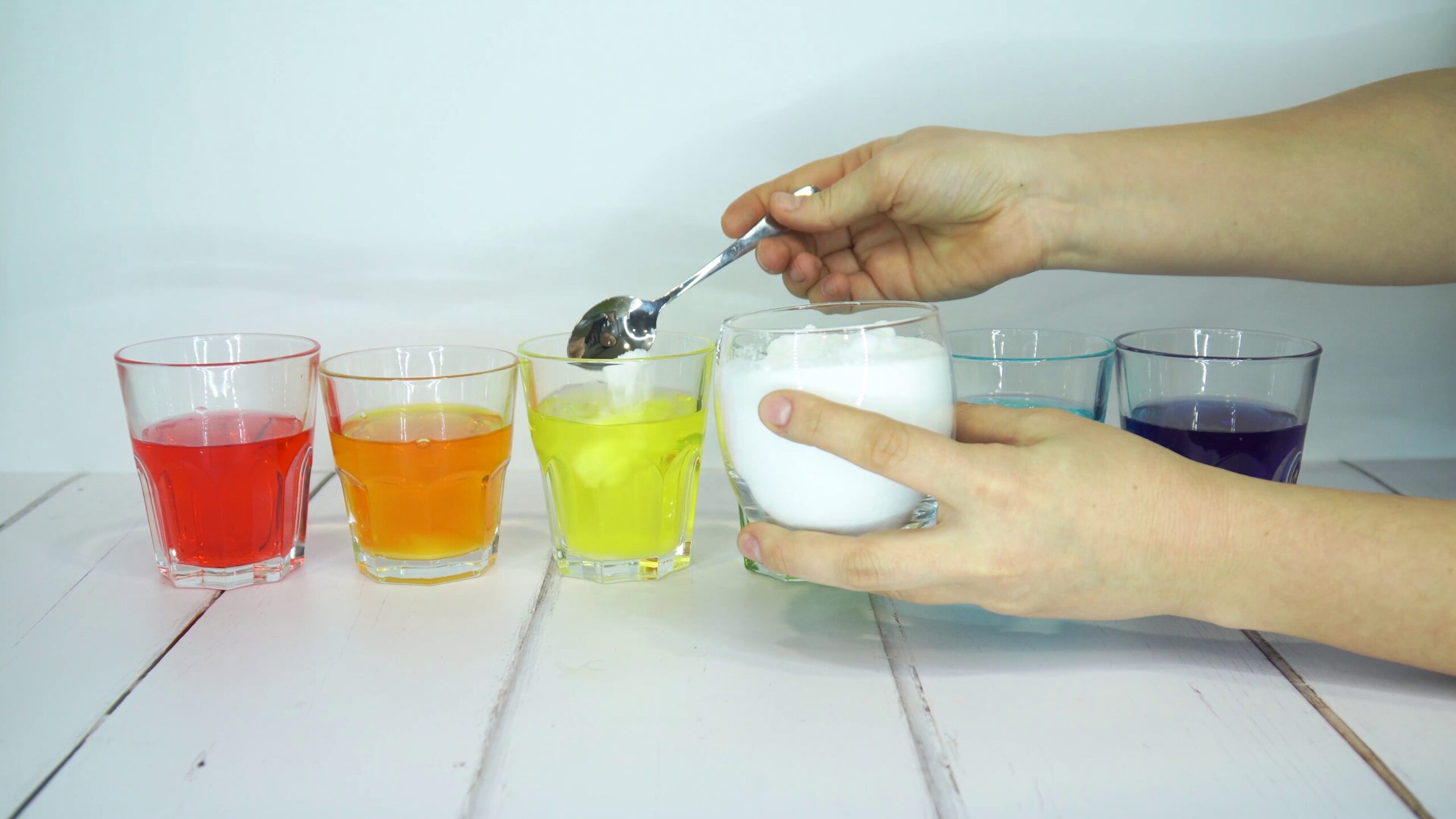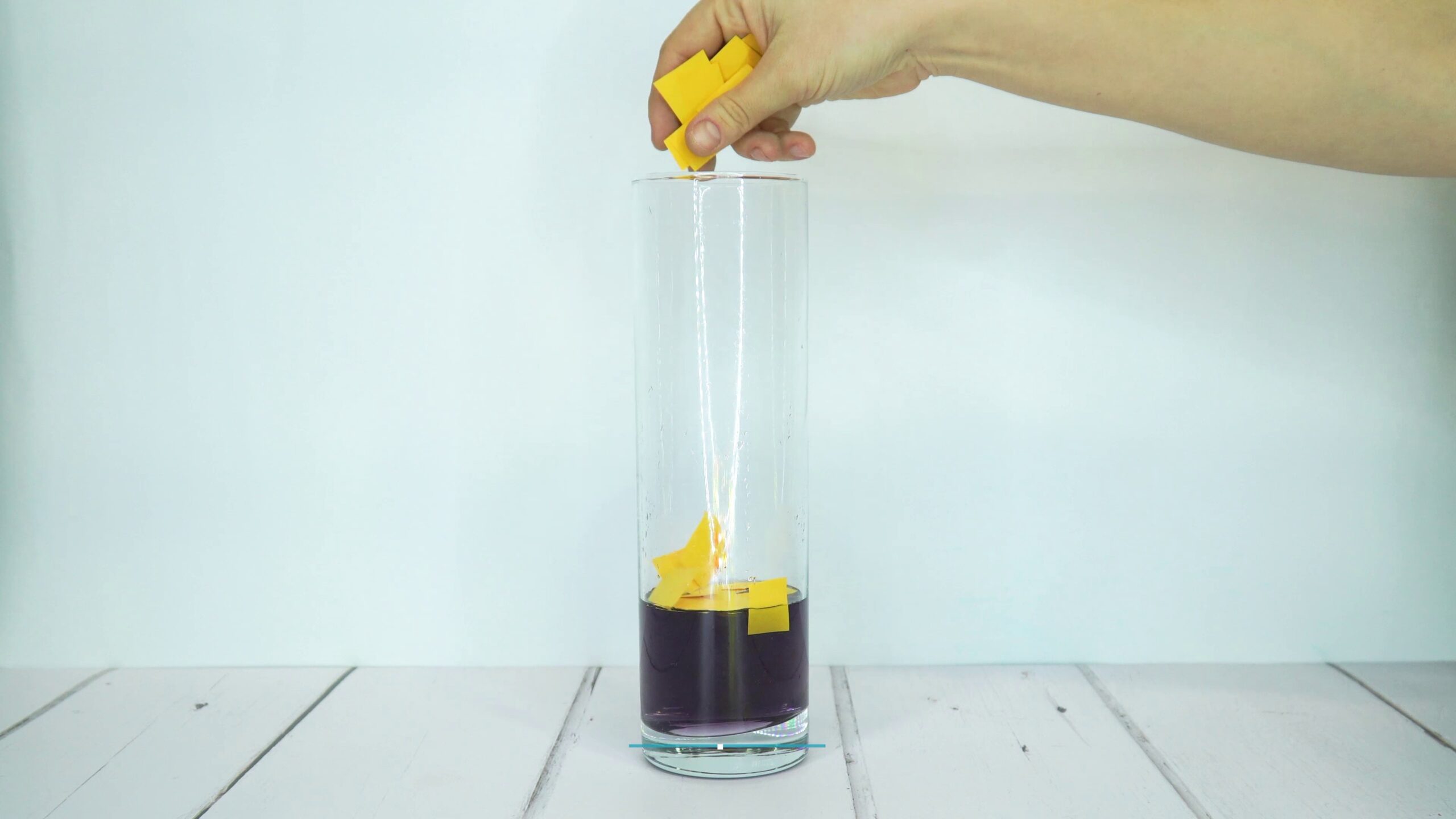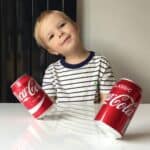-
9-10 , 12+
-
5 to 20 min
-
Hard

The rainbow density tower experiment is a great way to teach your kids about how the density of water can change when something is dissolved in it and is a good way to introduce older children to the idea of how salty seawater and freshwater interact in our oceans. Max was amazed by the result of this experiment, and had thousands of questions about what was going on! This experiment can be performed with salt or sugar. It can be performed with at least two different types of food colouring, but the more you use the better it looks! Why don’t you try to make 3 or 4 layer density tower, or even 6 layer tower as we did in the video below.
List of Materials for Density Tower Project
It’s important to consider the volumes of the glasses and the tall beaker. Ideally, the volume of water in It’s important to consider the volumes of the glasses and the tall beaker. Ideally, the volume of water in the glasses will fill the tall beaker/vase. If you don’t have the correct equipment for this, just make sure you don’t accidentally fill the tall beaker/vase up only a few of your mixtures! Ideally, an equal volume of each coloured liquid is added.
How to Make Density Tower: Step by Step Instructions
Fill up the glasses with cold tap water. Remember – use one glass for each different colour of food colouring that you are using!

Add a few drops of food colouring to each of the glasses, so the water in each glass turns a different colour.

Add the sugar or salt to the glasses. This should be done in an orderly fashion so that the water in the glasses becomes progressively saltier (or sugarier). The first glass should be left without salt/sugar. Using a teaspoon to measure, add one teaspoonful of sugar/salt to the first glass. Add two to the second glass, three to third etc.

Stir each glass thoroughly with the teaspoon, making sure to wipe down the spoon with a paper towel between glasses. These are now ready to be transferred to the tall beaker/vase!

Pour the glass with the most sugar/salt added into the tall beaker/vase.

Add torn up pieces of blotting paper to the tall beaker/vase. You should add enough that they create a near-continuous surface on the top of the water in the beaker.

Now it’s time to prepare the funnel. Attach the straw to the end of the funnel with some sticky tape.

Take the funnel and straw and arrange the straw in the beaker so it will feed water to just above the layer of blotting paper. If the straw enters the layer of water below, the layers will get mixed up and the experiment won’t work. Similarly, if you pour the water in vigorously or let the water drop from a height, the layers will be disturbed.

Carefully and slowly begin pouring the second saltiest glass of water into the funnel, raising the staw as the water level rises.

Repeat this process, working from the glasses with the most salt/sugar added, until you get to the one with no salt/sugar added.

Sit back and watch the colourful layers become more and more distinct!

You may also like 8-Layer Density Column
Video Tutorial
If you liked Rainbow Density Tower, you may like our 8-Layer Density Column experiment too.
The Science Explained
This experiment doesn’t just look great, it can teach us a few cool things about water and what happens when something dissolves, and about the concept of density.
When a solid substance like salt or sugar is mixed into the water – it disappears! This is because it is soluble – which is a fancy word that means it dissolves. What happens when the salt or sugar dissolves? It doesn’t just disappear but becomes suspended in the water. The water makes the salt/sugar molecules break apart into smaller pieces, which are then carried apart by the water. Nature likes things that are evenly spread out, so the salt/sugar will mix into the water until it is evenly spread.
Why do the different coloured layers of water stay distinct from one and another, and not mix? The different layers of water have different amounts of salt/sugar added to them. This changes a characteristic of the water known as density. Water with two teaspoonfuls of salt/sugar dissolved in it is more ‘dense’ compared to water with one teaspoonful of water dissolved into it. A good way to imagine salty water is that it is ‘busier’ with salt particles.
More dense, or busier water, is heavier than less dense water. More dense water will want to stay at the bottom of the beaker, and the less dense water will effectively float on top of it. The two liquids will only mix a little but are generally quite happy to stay separate.

Going Deeper Into The Science
When we’re talking about salt/sugar dissolving in water, there are some keywords that we should understand. In this experiment, salt or sugar (or the thing that dissolves) is called a solute, and water (what the sugar/salt dissolves into) is called a solvent. When the salt/sugar is dissolved in the water, a solution is produced. So a solute + a solvent = a solution!
What happens when sugar or salt dissolves to form a solution? The answer is not as simple as the particles becoming suspended in water. Instead, we have to imagine a salt/sugar molecule and understand what holds it together. Let’s take salt – which is made up of ions of sodium and chloride, which have an ionic bond holding them together (an ionic bond is a force that holds two different particles together through a force similar to that seen in magnets). When salt is added to water, the sodium and chloride ions are more attracted to charged water particles than they are to each other. So effectively the water molecules pull the sodium and chloride ions apart, breaking the ionic bond that holds them together! The same happens with sugar, which has a slightly more complex molecular structure.
Why do the different coloured layers of water stay distinct and separate, rather than mixing? This happens because the different salt/sugar solutions have different densities. The density of a solution will correlate directly with how much salt/sugar has been added to it. Solutions of different densities won’t mix because the more dense solution will naturally want to sink below the less dense solution (in some ways density can be thought of as how ‘heavy’ a liquid is!). Mixing will occur gradually at the boundary, or if stirred, but otherwise the different solutions are happy to not interact.
This is an interesting concept when we think about salty seawater and the fresh water that is added to the oceans from melting ice (which is fresh, or not salty). Saltwater and freshwater will behave differently – with saltwater sinking deeper in the oceans and freshwater wanting to stay at the surface. This is a very important concept in oceanic science and plays a big part in ocean circulation. Temperature is another important variable in oceanic circulation. If you want to know more about this, google ‘thermohaline circulation.
How to Take the Liquid Density Tower Experiment Further
Water temperature is a variable that can be altered in this experiment and gives a range of interesting results.
On the one hand, heat helps a solute to dissolve into a solvent. Why not measure how many spoonfuls of sugar or salt will dissolve in a glass of cold water vs a glass of warm water?
Temperature is also a major control of density. A cold solution will be denser than a warm one, even if they have the same amount of solute dissolved in them. What happens if the temperature of the different solutions is mixed up, with some being warm and others being cold? (Spoiler alert: your nice colourful layers of water will probably mix!).










Thank you! I will try it with my daughter tonight
Hi John! I am glad to hear this. I am sure you will have a wonderful time together exploring density and rainbows (:
YOOOOOOOOOOOOOOOO THIS IS SICK BRUHHH CAN YOU BE MY DAD LAB